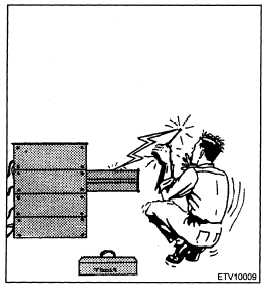CHAPTER 3
ELECTRONICS SAFETY
ELECTRIC SHOCK
connection entered the ET3’s thumb and
forearm before finding its way to ground.
Ninety-nine percent of what you do, you’ll do
The ET3 went to medical and the corpsman
around electricity. This makes you extremely
sent him to the naval hospital for evaluation and
susceptible to electric shock. It’s very important for you
observation. The technician was released the
to know these four things about electric shock:
next day.
1. What it is.
2. What factors affect how severe it can be.
3. How to avoid it.
4. What to do if you see someone being shocked.
DEFINITION OF ELECTRIC SHOCK
Electric shock is the sensation and muscular spasm
caused when electric current passes through the body.
Note that the word current is bold in the last sentence.
This is to emphasize that it is current and NOT the
voltage that causes electric shock. No matter how much
voltage is present, you’ll only get shocked if you
provide a ground-path for the electric current.
Here is an example taken from a mishap report:
While trying to align the RF turret
assembly of a high frequency transmitter, a
Third Class Electronics Technician (ET3)
received a shock from 1,000 volts of direct
current (dc).
While doing preventive maintenance, the
technician discovered the high frequency (HF)
transmitter did not meet the performance
specifications required by the Maintenance
Requirements Card (MRC) of the Planned
Maintenance System (PMS). After trying to
tune the transmitter using the front panel meter,
the technician determined the turret assembly
was faulty.
The ET3 removed a high voltage insulation
cover to get into the transmitter turret assembly
adjustment fitting. While adjusting the turret,
his thumb brushed a power amplifier tube plate
connection. The 1,000 volts dc at the plate
SEVERITY OF ELECTRIC SHOCK
The following factors determine the severity of the
effect electric shock has on your body:
The amount of current that is flowing through
your body.
The path the current takes through your body.
The amount of body resistance you have to the
current flow.
The length of time the current flows through
your body.
Path of Current Flow
The two most dangerous paths that current can take
through your body are from (1) hand to hand, or (2) from
3 -1

